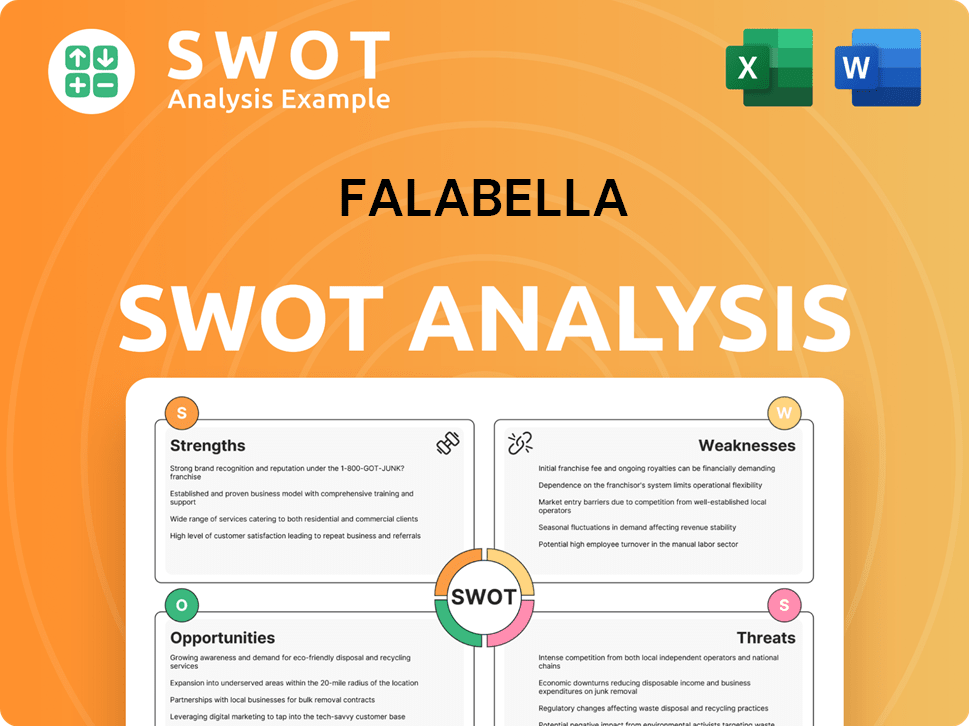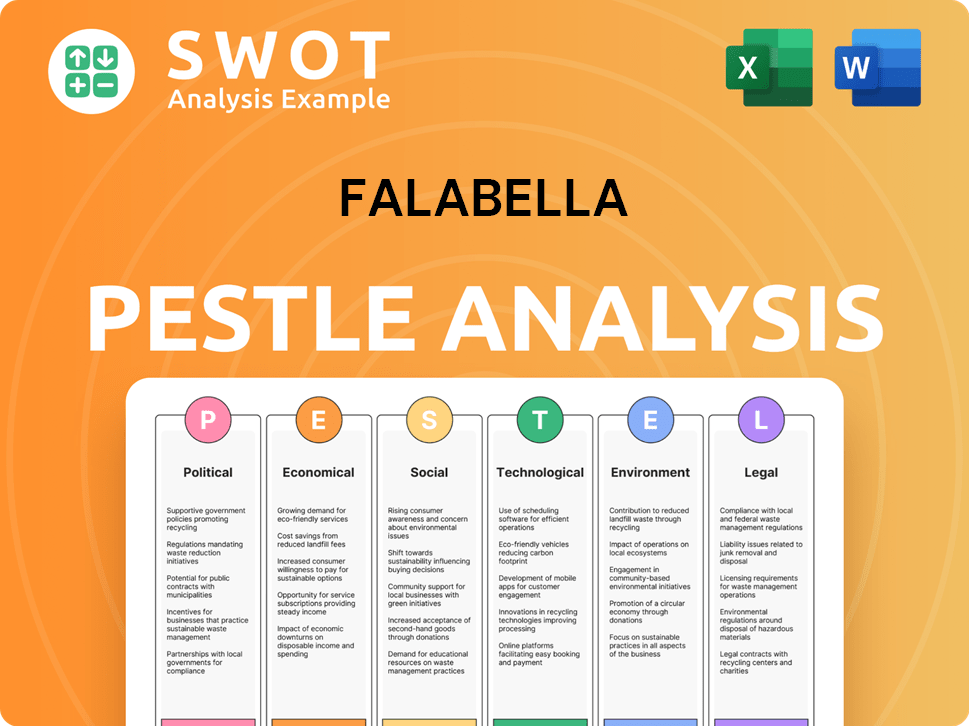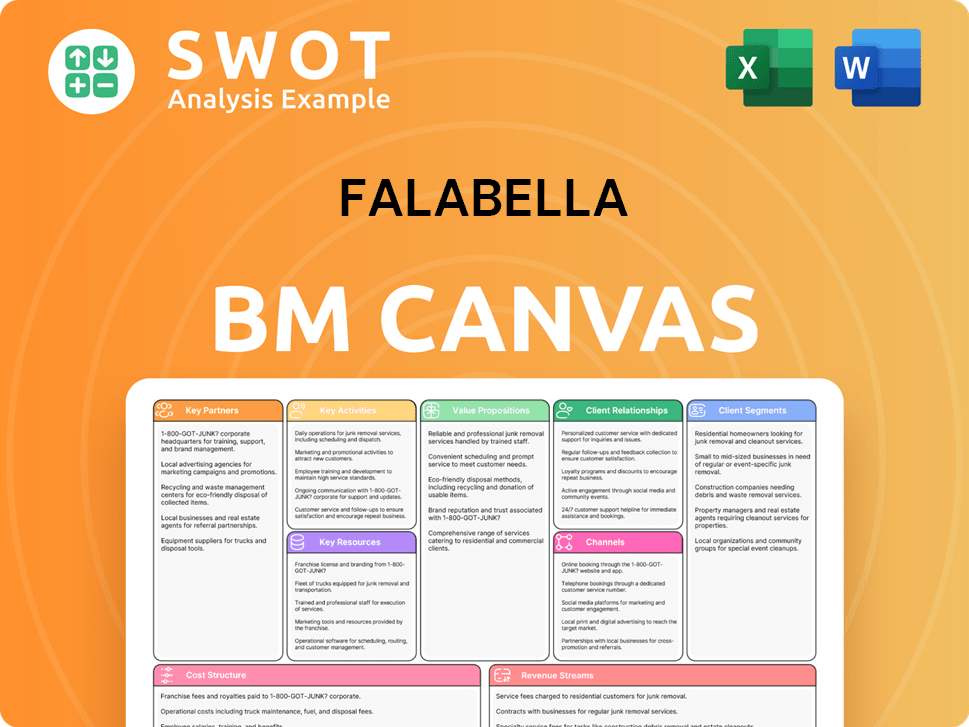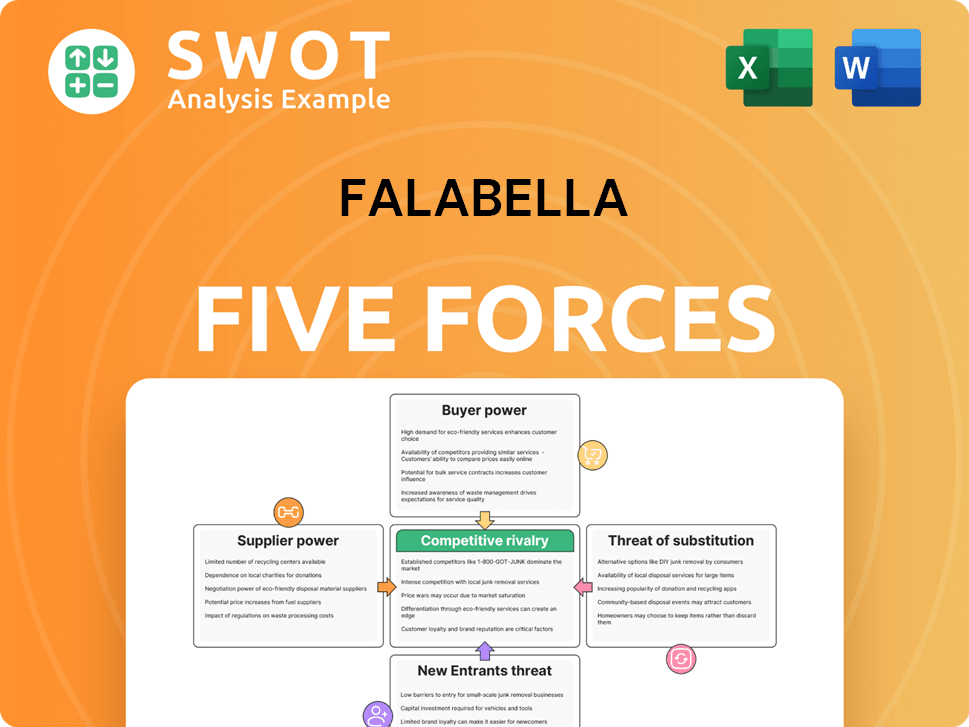Falabella Bundle
How Well Does Falabella Know Its Customers?
In the competitive Latin American retail market, understanding customer demographics and target markets is crucial for success. Falabella, a retail giant with a vast presence across multiple sectors, must constantly adapt to evolving consumer behaviors. This exploration delves into Falabella's customer base, examining their characteristics, needs, and how the company tailors its strategies to meet them.

From department stores to financial services, Falabella's diverse offerings cater to a wide spectrum of consumers. Analyzing the Falabella SWOT Analysis, reveals how the company strategically segments its market. This analysis will help you understand Falabella's customer profile, from their age range and income levels to their lifestyle and preferences, providing valuable insights into their target market and how Falabella aims to meet their needs.
Who Are Falabella’s Main Customers?
Understanding the customer demographics and target market for the various business units of the company is key to its success. With a customer base exceeding 36 million individuals, the company strategically targets a broad consumer base (B2C) through its diverse offerings. This wide reach necessitates a nuanced approach to market segmentation, considering the varying needs and preferences of different customer groups.
The primary customer segments of the company are diverse, reflecting the varied offerings of its department stores (Retail), home improvement stores (Sodimac), supermarkets (Tottus), and financial services (Banco). Each segment has a unique consumer profile, shaped by factors such as income, lifestyle, and purchasing behavior. Analyzing these segments helps the company tailor its products, services, and marketing strategies to meet the specific needs of each group effectively.
While specific demographic breakdowns by age, income, or education for each segment are not publicly detailed, general trends can be inferred from their business focus and regional presence. The company's ability to adapt to evolving consumer behaviors and competitive pressures, as highlighted in this analysis of Growth Strategy of Falabella, is crucial for maintaining its market position.
The target audience for Falabella Retail likely includes middle to upper-income individuals and families. These customers are typically seeking fashion, beauty products, electronics, and home decor. The focus is on providing a wide range of products to meet the needs of a diverse customer base.
Sodimac caters to homeowners, contractors, and individuals involved in construction or home improvement projects. This suggests a customer base with varying income levels but a common need for building materials and home goods. The focus is on providing a wide range of products to meet the needs of a diverse customer base.
Tottus supermarkets serve a broad consumer base, focusing on daily household needs. This implies a wide range of income levels and family statuses. The supermarkets aim to provide essential goods to a diverse customer base.
Banco Falabella's customer base includes individuals seeking banking services and credit. Over 800,000 new cards and checking accounts were opened in 2024, indicating a growing reach into the financial services sector. This segment caters to those looking for financial products and services.
The company has shifted its strategy to emphasize an omnichannel approach, recognizing the increasing importance of digital channels alongside its physical footprint. This shift is prompted by evolving consumer behaviors and competitive pressures from e-commerce players. The focus on accelerating third-party e-commerce growth within Falabella Retail and strengthening its digital banking segment indicates a strategic move towards a younger, digitally-savvy demographic, while still serving its traditional customer base.
- The company is investing in digital channels to reach a younger demographic.
- The omnichannel approach aims to provide a seamless customer experience across all channels.
- The company is adapting to the changing needs and preferences of its customers.
- The focus is on providing financial services and credit to a broad customer base.
Falabella SWOT Analysis
- Complete SWOT Breakdown
- Fully Customizable
- Editable in Excel & Word
- Professional Formatting
- Investor-Ready Format

What Do Falabella’s Customers Want?
Understanding the customer needs and preferences is crucial for the success of any business. For the company, this involves catering to diverse needs across its various retail formats. Customers are driven by desires for convenience, value, and a wide selection of products, influencing their purchasing decisions.
The company's approach to meeting customer needs is multifaceted, focusing on quality, brand reputation, and a seamless shopping experience. The company's market segmentation strategy addresses different customer segments, from those seeking fashion and electronics to those needing home improvement supplies or daily groceries. This strategy allows the company to tailor its offerings and services to meet the specific needs of each group.
The company's commitment to understanding its customers is evident in its omnichannel strategy, which integrates physical stores and digital platforms. This approach aims to provide a consistent and convenient shopping experience, addressing common pain points such as limited product selection or inconvenient shopping experiences. The company continually evolves its offerings based on customer feedback and market trends.
Customers are drawn to the company by the value it offers, combined with the convenience of a 'one-stop-shop' experience. This is particularly evident in its department stores, where customers seek quality fashion, beauty products, and electronics. The company's focus on convenience extends to its online platforms as well.
The company has seen significant growth in its e-commerce sector, indicating a shift towards online purchasing. For example, Sodimac experienced an 18% year-over-year growth in e-commerce in 2024. This trend highlights the importance of digital platforms in meeting customer needs.
The company enhances its value proposition through loyalty programs and financial services. The 'Puntos + Pesos' initiative in Chile allows customers to combine loyalty points with cash, increasing the value for participants. As of Q3 2024, the company's loyalty programs had 20.3 million participants in the Andean region.
Customer feedback and market trends are crucial in shaping product development and service enhancements. Tottus is transforming its store experiences through design changes and focusing on food categories. This reflects the company's responsiveness to evolving consumer preferences.
The company's omnichannel strategy aims to provide a seamless shopping experience. This integration between physical stores and digital platforms addresses customer pain points. This approach ensures that customers can shop conveniently across different channels.
The company offers financial services to facilitate customer purchases. Access to these services enhances the overall shopping experience. These services are designed to make shopping more accessible and convenient for a broader range of customers.
The company's customer-centric approach is further detailed in an analysis of its Revenue Streams & Business Model of Falabella. This focus on customer needs and preferences, combined with strategic market segmentation, allows the company to maintain its strong market position and adapt to changing consumer behaviors. The company's ability to provide value, convenience, and a wide range of products positions it well for continued growth in a competitive market. The company's target market analysis reveals a focus on meeting the diverse needs of its customers through a blend of physical and digital retail experiences.
The company's success hinges on understanding and catering to key customer preferences across its various business segments. This involves offering a blend of quality products, competitive pricing, and convenient shopping experiences.
- Convenience: Customers value ease of shopping, both online and in-store.
- Value: Competitive pricing and promotions are essential for attracting customers.
- Product Assortment: A wide selection of products across various categories is crucial.
- Brand Reputation: Trust in a well-established brand influences purchasing decisions.
- Financial Services: Access to credit and other financial services enhances the shopping experience.
Falabella PESTLE Analysis
- Covers All 6 PESTLE Categories
- No Research Needed – Save Hours of Work
- Built by Experts, Trusted by Consultants
- Instant Download, Ready to Use
- 100% Editable, Fully Customizable

Where does Falabella operate?
Falabella operates as a multinational retail company with a strong presence across Latin America. Its primary markets include Chile, Peru, Colombia, Argentina, Brazil, Uruguay, and Mexico. The company's strategic focus and investment are geared towards these key geographical areas, where it tailors its offerings to meet local consumer preferences.
The company's success is significantly tied to its ability to understand and cater to its diverse customer base across different regions. This involves adapting product assortments, pricing strategies, and promotional activities to align with local market conditions and consumer behaviors. This approach is crucial for maintaining and expanding its market share in competitive environments.
In 2024, Falabella demonstrated robust performance in several key markets. For instance, the company reported double-digit revenue growth in Brazil (14.3%), Colombia (24.2%), and Peru (14%). Retail revenues in Chile grew by 1.1%, reflecting a stable performance in its home market. This geographical diversification and localized approach are central to Falabella's strategic expansion and market penetration.
Falabella's presence is particularly strong in Chile and Peru, where it holds significant market share and brand recognition. For example, Tottus holds the #2 market share in Peru. These markets are crucial for the company's overall financial performance and strategic growth initiatives.
The company has an investment plan of US$650 million for 2025, with a focus on opening 15 new stores across its various brands. This investment also includes significant funds for the transformation and expansion of existing stores and shopping centers, as well as for technological capabilities. This highlights the company's commitment to growth and market consolidation.
Falabella localizes its offerings and marketing strategies to succeed in diverse markets. This includes adapting product assortments, pricing, and promotional activities to align with local consumer preferences and economic conditions. This approach is key to its success in different regions.
Banco Falabella aims to increase loan placements in Chile, improve profitability in Peru and Colombia, and diversify its product portfolio in Mexico. This expansion of financial services is an integral part of Falabella's strategy to increase customer engagement and revenue streams.
The company's strategy includes a focus on expanding in key markets like Mexico, with plans for Sodimac. Tottus plans to expand its physical presence in Peru and enhance its value proposition in Chile. Mallplaza is consolidating its footprint in Peru and continuing to modernize and expand malls across the region. For more information about the company's structure, you can read about Owners & Shareholders of Falabella.
Falabella Business Model Canvas
- Complete 9-Block Business Model Canvas
- Effortlessly Communicate Your Business Strategy
- Investor-Ready BMC Format
- 100% Editable and Customizable
- Clear and Structured Layout

How Does Falabella Win & Keep Customers?
Customer acquisition and retention strategies are crucial for the success of any retail business. For the company, this involves a multifaceted approach that integrates both traditional and digital channels. The goal is to attract new customers while also fostering loyalty among existing ones.
The company's strategy includes extensive use of digital advertising, social media engagement, and traditional media to reach diverse customer segments. A significant investment in technological capabilities, amounting to US$166 million as part of its US$650 million investment plan for 2025, highlights the company's commitment to digital acquisition strategies. This includes strengthening its e-commerce and digital banking services. The company also focuses on refining the in-store customer experience and enhancing the monetization of its physical channels.
The company's approach utilizes data and CRM systems to target campaigns and personalize customer interactions. Loyalty programs play a central role in its retention strategy. The company aims to enhance customer loyalty and lifetime value by offering a seamless and personalized shopping experience across all touchpoints.
The company leverages digital advertising, social media, and its Fmedia retail media platform. The Fmedia platform achieved 30% sales growth for participating brands in 2024. ROIs reached 9x during key events, showcasing its effectiveness in digital advertising.
Sales tactics include competitive pricing, diverse product assortments, and a strong omnichannel presence. The company focuses on enhancing the in-store experience and monetizing physical channels. These strategies aim to attract and retain customers across various touchpoints.
Customer data and CRM systems are critical for targeted campaigns and personalized interactions. This approach helps understand customer behavior and deliver seamless experiences. By using data, the company can tailor its offerings to meet customer needs.
Loyalty programs are key to customer retention. As of Q3 2024, the company's loyalty program had 20.3 million participants in the Andean region. There were 7.8 million active customers using its payment methods, demonstrating the program's significance.
The company maintains a customer-oriented approach by leveraging data to understand customer behavior. This strategy ensures a seamless shopping experience across all touchpoints. The company’s focus on customer needs and preferences is central to its market strategy.
- The company's 'Puntos + Pesos' (points + cash) initiative in Chile incentivizes repeat purchases.
- After-sales service, including robust customer support and efficient returns, enhances customer satisfaction.
- The company’s strategic adjustments and the strong performance of its digital business in 2024 contribute to sustained growth.
- The goal is to enhance customer loyalty and lifetime value.
Falabella Porter's Five Forces Analysis
- Covers All 5 Competitive Forces in Detail
- Structured for Consultants, Students, and Founders
- 100% Editable in Microsoft Word & Excel
- Instant Digital Download – Use Immediately
- Compatible with Mac & PC – Fully Unlocked

Related Blogs
- What are Mission Vision & Core Values of Falabella Company?
- What is Competitive Landscape of Falabella Company?
- What is Growth Strategy and Future Prospects of Falabella Company?
- How Does Falabella Company Work?
- What is Sales and Marketing Strategy of Falabella Company?
- What is Brief History of Falabella Company?
- Who Owns Falabella Company?
Disclaimer
All information, articles, and product details provided on this website are for general informational and educational purposes only. We do not claim any ownership over, nor do we intend to infringe upon, any trademarks, copyrights, logos, brand names, or other intellectual property mentioned or depicted on this site. Such intellectual property remains the property of its respective owners, and any references here are made solely for identification or informational purposes, without implying any affiliation, endorsement, or partnership.
We make no representations or warranties, express or implied, regarding the accuracy, completeness, or suitability of any content or products presented. Nothing on this website should be construed as legal, tax, investment, financial, medical, or other professional advice. In addition, no part of this site—including articles or product references—constitutes a solicitation, recommendation, endorsement, advertisement, or offer to buy or sell any securities, franchises, or other financial instruments, particularly in jurisdictions where such activity would be unlawful.
All content is of a general nature and may not address the specific circumstances of any individual or entity. It is not a substitute for professional advice or services. Any actions you take based on the information provided here are strictly at your own risk. You accept full responsibility for any decisions or outcomes arising from your use of this website and agree to release us from any liability in connection with your use of, or reliance upon, the content or products found herein.